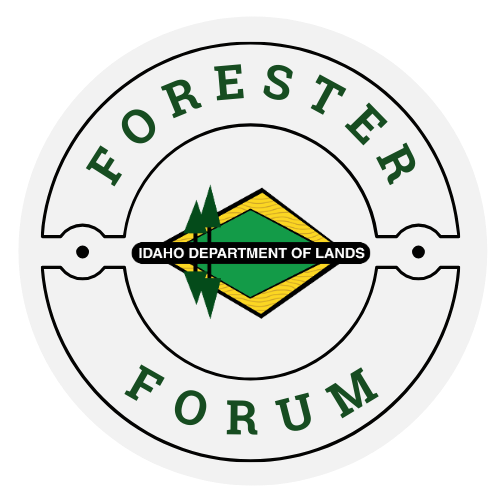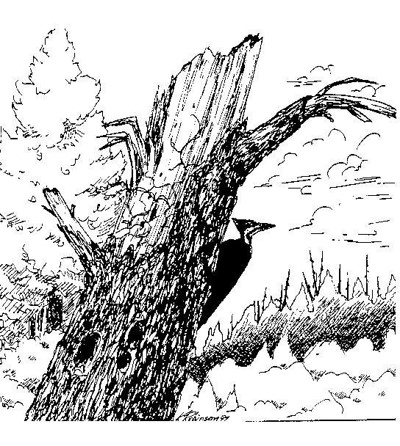Forest Management 9: Snag Management

Snag Management
In this edition of the Forester Forum
Overview
A snag is a standing dead or dying tree. It may have died because of wildfire, insects, disease, lightning, or a combination of factors. Regardless of the reason for its death, a snag can be very important to many kinds of wildlife.

Why Are Snags Important?
Snags provide food and shelter for many creatures. Woodpeckers hunt for insects and nest in snags. Bats hibernate under the thick, loose bark of large snags. Insects reside within the dead wood and help speed up the process of decay and nutrient recycling. Wood ducks and bluebirds nest in cavities created by previous residents. Snags provide convenient perches for hunting hawks and owls. Bald eagles often use large cottonwood snags or dead topped trees near lakes or rivers for perching, nesting and roosting.
For many kinds of wildlife, snags are a critical habitat component. Nothing can replace snags for these species. For example, some woodpeckers excavate new nest and roost holes every year. These birds are known as primary cavity nesters. Other cavity nesting birds and animals use old, vacated cavities. They are known as secondary cavity nesters. Bats, bluebirds, pine martens and owls are examples of secondary cavity nesters. Nest boxes can provide cavity habitat for secondary cavity nesters if snags aren’t available but suitable snags are essential for primary cavity nesters.
Snags are important to people in both direct and indirect ways. Many homes are heated by wood burning stoves. Woodpeckers, bats and other insectivorous (insect-eating) creatures are very beneficial to landowners because they can help prevent damaging insect outbreaks or help control insect epidemics in the early stages. Many people enjoy watching woodpeckers, bluebirds and other wildlife that inhabit snags.
Which Snags are Best?
From a wildlife point of view, some trees are more suitable for snags than others. Each snag dependant species has its own unique criteria for determining which snag it uses. Tree species, height, diameter, the stage of decay, the distribution of other snags in the area (clumped or scattered), and the successional stage of the plant community where the snag occurs (such as a field, a young forest or an old growth stand) are all important factors.
Generally speaking, hardwoods like birch, aspen, and cottonwood and softwoods like western larch, ponderosa pine, and western redcedar are the most valuable tree species for cavity nesters. Other tree species that can make suitable snags include, in order of preference, Douglas fir, grand fir, western hemlock, lodgepole pine, spruce, subalpine fir and western white pine. The order of preference varies somewhat, depending on the species of wildlife. For example, yellow-bellied sapsuckers live in aspen/birch and riparian/cottonwood communities. White-headed and Williamson’s woodpeckers nest and feed in ponderosa pine and mixed conifer forests. Blackbacked three toed woodpeckers are found in lodgepole pine and subalpine fir communities. Each of these kinds of birds prefer different types, sizes and numbers of snags.
Snag size is an important factor. The basic rule of thumb is “the bigger, the better”. To be valuable for most cavity nesters, snags must be at least 10 inches in diameter and 20 feet tall. Pileated woodpeckers require a snag at least 20 inches in diameter for nesting.
There are two types of snags, soft and hard. A hard snag is composed mostly of sound wood, especially on the outside. The top is usually intact and many dead branches remain. Soft snags are snags which are in the advanced stages of decay. Soft snags usually have broken tops and few limbs. Hard snags eventually become soft snags. Some tree species tend to become hard snags much more readily than others, due to their decay characteristics. Both soft and hard snags have habitat value for cavity dependent wildlife because soft snags are preferred by some species and hard snags are more important to other species.
How Can I Provide Snags on My Forest Land?
There are a number of ways to provide an adequate and continuous supply of snags for the cavity dependant wildlife in your area.
- Leave all existing snags and dying trees standing, especially those showing obvious signs of use by wildlife. Trees with root rot should not be used unless absolutely necessary, since they are unlikely to remain standing for very long. If a snag poses a safety hazard, remove it, but leave a substitute elsewhere.
- Identify and mark live trees that would make good snags in the future. These “recruitment trees” can be defective or cull trees, preferably occurring in clumps. Trees with dead or broken tops are especially good. Again, leave all trees with obvious signs of wildlife use. Designate at least two live trees for each future snag desired.
- Tall stumps may be used by wildlife in some instances, especially when they are large diameter. Leave tall stumps standing.
If necessary, snags can be created by girdling or topping (by blasting or sawing) live trees. Topping is usually the best choice because a topped tree will tend to remain standing longer than a girdled tree. Also, topping leaves a live tree that can still increase in diameter. - Nest boxes can be put up for secondary cavity users if suitable snags are not available. Keep in mind that if the needs of primary cavity nesters are being met, the needs of secondary nesters are usually being met, too.
How Many Snags Should I Leave?
Although there is no hard and fast answer, cavity dependant wildlife must have enough snags in their habitat for their populations to survive over time. Also, the more snags of various sizes that can be provided across a variety of community types, the larger and more diverse will be the populations of cavity users.
Deciding how many snags to leave depends on the specific site, the wildlife species under consideration and the wildlife population level desired (i.e. the desired percentage of an average population that the area will support). For example, the number of snags needed to maintain wildlife population levels at various percentages of normal in a mixed conifer community type are as follows:
Snag and Wood Debris Management Guidelines
| 100 % Level | 60% Level | 40% Level | |
| Number of Snags Needed per 100 Acres | 14 > 20″ | 8 > 20″ | 6 > 20″ |
| 136 > 12″ | 82 > 12″ | 55 > 12″ | |
| 75 > 10″ | 45 > 10″ | 30 > 10″ | |
| Totals | 225/100 AC | 135/100 AC | 90/100 AC |
| From IPNF Snag and Wood Debris Management Guidelines | |||
Other important considerations include the quality of cavity habitat available elsewhere in the area, the logging system used for timber harvest, the type of site preparation, and other factors. Snags less than 10 inches in diameter should be left if possible, but should not be counted as part of the total number of snags per acre. Large snags can be substituted for small ones to meet wildlife needs, but never vice versa.
By leaving snags you help maintain a wildlife legacy for future generations to enjoy.


